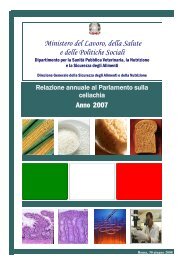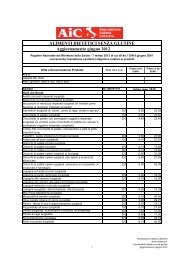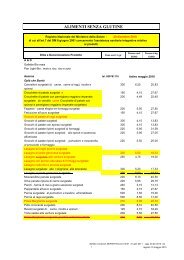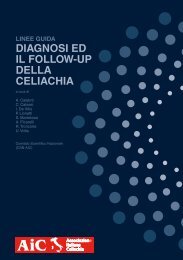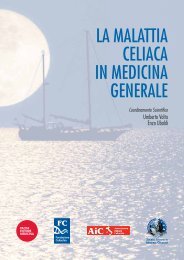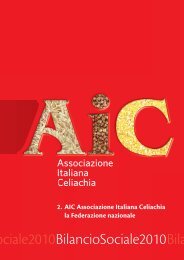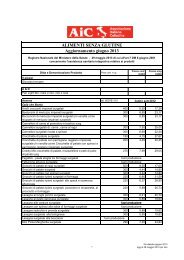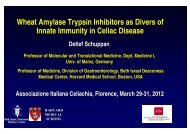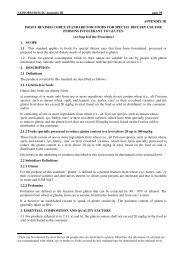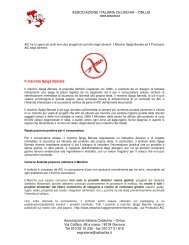primary prevention of coeliac disease - Associazione Italiana ...
primary prevention of coeliac disease - Associazione Italiana ...
primary prevention of coeliac disease - Associazione Italiana ...
Create successful ePaper yourself
Turn your PDF publications into a flip-book with our unique Google optimized e-Paper software.
Catassi C, Fasano A, Corazza GR (eds):<br />
Primary <strong>prevention</strong> <strong>of</strong> <strong>coeliac</strong> <strong>disease</strong>. The<br />
utopia <strong>of</strong> the new millennium? Perspectives on<br />
Coeliac Disease, vol. 1, AIC Press, pp 43-60<br />
Primary <strong>prevention</strong> <strong>of</strong> <strong>coeliac</strong> <strong>disease</strong><br />
by favourable infant feeding practices<br />
1,2 1,3<br />
Anneli Ivarsson , Lars Åke Persson and Olle Hernell 2<br />
1 2<br />
Department <strong>of</strong> Public Health and Clinical Medicine, Epidemiology and Department<br />
3<br />
<strong>of</strong> Clinical Sciences, Pediatrics, both at Umeå University, Umeå, Sweden, and ICDDR,B:<br />
Centre for Health and Population Research, Dhaka, Bangladesh.<br />
Coeliac <strong>disease</strong> is now recognised as a common health problem throughout a large<br />
1-12<br />
part <strong>of</strong> the world . An effective treatment is available through adherence to a strict<br />
gluten-free diet. Screening studies have revealed that most cases are undiagnosed,<br />
which indicates the need for active case recognition, and possibly also a need for<br />
13-14<br />
screening efforts . However, even when <strong>coeliac</strong> <strong>disease</strong> has been diagnosed, the<br />
widespread use <strong>of</strong> gluten-containing foods makes compliance with the treatment<br />
15<br />
difficult . Clearly, then, it is desirable to explore additional strategies such as <strong>primary</strong><br />
<strong>prevention</strong>.<br />
Family clustering<br />
The risk for <strong>coeliac</strong> <strong>disease</strong> is higher in first degree relatives compared to the general<br />
population. In family members <strong>of</strong> <strong>coeliac</strong> patients, a prevalence <strong>of</strong> 10% is <strong>of</strong>ten<br />
16<br />
mentioned , and in monozygous twins the concordance rate has been estimated at<br />
17-18 19<br />
70% , or even higher .<br />
Family clustering is generally considered as evidence for a strong genetic influence<br />
in <strong>coeliac</strong> <strong>disease</strong> susceptibility. However, the fact that family members share not only<br />
genetics but, in many respects, also the same environment, should be taken into<br />
consideration. This is especially true for monozygous twins, who have a similar<br />
environment not only during childhood, as is the case for most siblings, but also have a<br />
similar environment in utero.<br />
A complex aetiology<br />
The aetiology <strong>of</strong> <strong>coeliac</strong> <strong>disease</strong> is not fully understood, largely as a consequence <strong>of</strong><br />
its complexity, although our understanding <strong>of</strong> different aspects <strong>of</strong> the <strong>disease</strong> process is<br />
rapidly increasing. Based on present knowledge, an immunological pathogenesis for<br />
the <strong>disease</strong> seems most likely. In some genetically susceptible individuals, exposure to<br />
gluten, or related proteins in rye and barley, triggers an errant immune response, which<br />
43





